We know the Arctic is warming—what will changing river flows do to its environment?
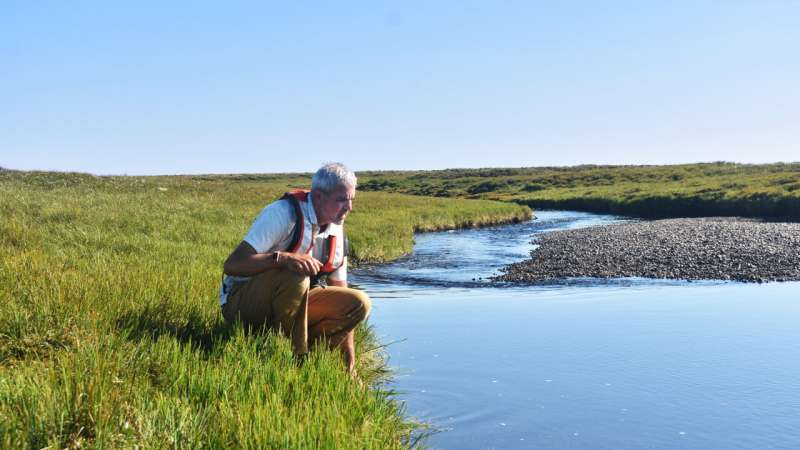
Scientists at the University of Massachusetts Amherst recently combined satellite data, field observations, and sophisticated numerical modeling to paint a picture of how 22.45 million square kilometers of the Arctic will change over the next 80 years.
As expected, the overall region will be warmer and wetter, but the details—up to 25% more runoff, 30% more subsurface runoff, and a progressively drier southern Arctic, provide one of the clearest views yet of how the landscape will respond to climate change. The results were published in the journal The Cryosphere.
The Arctic is defined by the presence of permafrost—the permanently frozen layer on or under the Earth's surface. It's that permafrost that drives everything from seasonal runoff to the freshwater dumping into coastal lagoons to the amounts of soil carbon that wind up flowing into the ocean.
But the Arctic is warming two-and-a-half to four times faster than the global average, which means that massive amounts of carbon-rich soils in permafrost regions are thawing, releasing their carbon to rivers and the atmosphere every year. The thawing is also intensifying the Arctic's water cycle—the continuous loop of precipitation, runoff, and evaporation that, in part, determines a region's environment.
The upper part of the permafrost that thaws each summer is called the active layer, and it has been of particular interest to Michael Rawlins, associate professor in the Department of Earth, Geographic and Climate Sciences at UMass Amherst and the paper's lead author. As the Arctic warms, the active layer is getting thicker, and Rawlins wanted to know how that thickening, combined with warming and an intensified water cycle, would affect the terrestrial Arctic environment.
Rawlins has spent the last 20 years building and refining his Permafrost Water Balance Model, which accounts for the seasonal thawing and freezing of permafrost and how it influences runoff, subsurface water pathways, river flows and other aspects of the region's hydrology.
To do this, Rawlins teamed up with the U.S. National Science Foundation, the U.S. Department of Energy, NASA and Ambarish Karmalkar, a research assistant professor at UMass Amherst when he completed the research and now an assistant professor of geosciences at the University of Rhode Island.
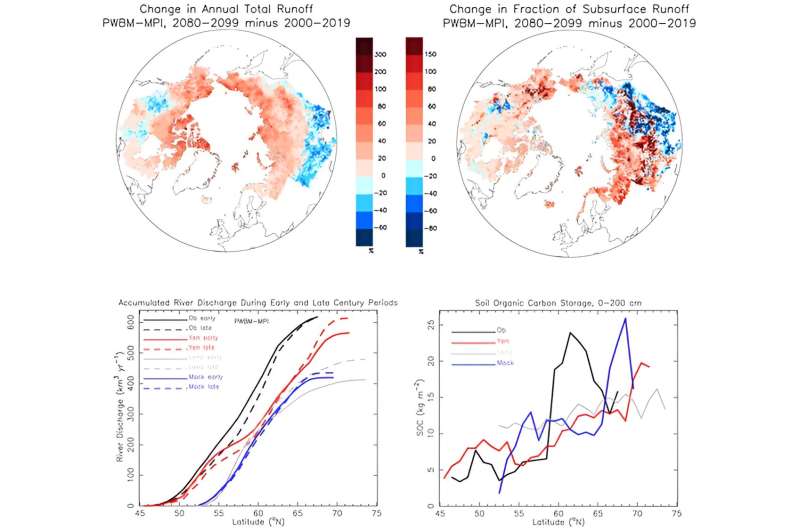
Karmalkar is an expert in the use of global climate models, and he and Rawlins used precipitation and temperature scenarios from two of them to envision two different possibilities for the future: a moderate case in which greenhouse gas emissions, and so global temperatures, are curbed; and a high emissions and warming scenario.
Rawlins then fed the climate-model data into his Permafrost Water Balance Model, and what he discovered is that the thawing permafrost and associated thickening of the active layer which, Rawlins says, "acts like a giant bucket," will fundamentally alter the region's hydrology.
"A thicker active layer creates a bigger bucket for storing water," says Rawlins. "Our work shows that as precipitation intensifies, the water will be stored longer in thawed soils and released at a later time via subsurface pathways, instead of running off immediately into rivers and streams, as much of it does now."
The study demonstrates how thawing soils will increase runoff to rivers in fall because the ground won't freeze as early in a warmer world. Between now and 2100, the yearly proportion of subsurface runoff will increase by up to 30%.
Moreover, this increased runoff will happen mainly in the northern parts of the Arctic. Some of the additional water will originate from evaporation caused by an increasingly ice-free Arctic Ocean. And southern portions of the Arctic will warm so much that evaporation and plant transpiration will send much of the additional precipitation back to the atmosphere, resulting in an overall drying out of the landscape.
All of this has a number of implications for the Arctic: northern rivers, especially the region's largest, the Ob, Yenesey, Lena, and Mackenzie, will see proportionally more water coming from their northern reaches. Because there's more soil carbon in the northern Arctic, it is likely that more of it, some frozen for thousands of years, will wind up flowing through rivers to the Arctic Ocean.
The increased discharge will affect the dynamics of coastal sea ice, change the ecology of the biodiverse Arctic lagoons, and affect ocean freshwater storage, potentially slowing the Atlantic meridional overturning circulation (AMOC), which is responsible for maintaining the temperate climate of Northern Europe.
There's more work to be done, Rawlins says. "More field observations are needed from the small- and medium-sized rivers near the Arctic coast to understand better how warming will alter the land-to-ocean transport of freshwater and, in turn, impact Arctic environments and the flora, fauna and Indigenous populations that call the region their home."
More information: Rawlins, M. A. et al, Regime shifts in Arctic terrestrial hydrology manifested from impacts of climate warming, The Cryosphere (2024). DOI: 10.5194/tc-18-1033-2024. tc.copernicus.org/articles/18/1033/2024/
Provided by University of Massachusetts Amherst Carbon dissolved in Arctic rivers affects our world—here's how to study it
Arctic rivers face big changes with a warming climate, permafrost thaw and an accelerating water cycle − the effects will have global consequences
Water from the Mackenzie River, seen from a satellite, carries silt and nutrients from land to the Arctic Ocean.
Published: March 5, 2024
As the Arctic warms, its mighty rivers are changing in ways that could have vast consequences – not only for the Arctic region but for the world.
Rivers represent the land branch of the earth’s hydrological cycle. As rain and snow fall, rivers transport freshwater runoff along with dissolved organic and particulate materials, including carbon, to coastal areas. With the Arctic now warming nearly four times faster than the rest of the world, the region is seeing more precipitation and the permafrost is thawing, leading to stronger river flows.
We’re climate scientists who study how warming is influencing the water cycle and ecosystems. In a new study using historical data and sophisticated computer models of Earth’s climate and hydrology, we explored how climate change is altering Arctic rivers.
We found that thawing permafrost and intensifying storms will change how water moves into and through Arctic rivers. These changes will affect coastal regions, the Arctic Ocean and, potentially, the North Atlantic, as well as the climate.
Thawing permafrost: Big changes in Arctic soils
Permafrost thaw is one of the most consequential changes that the Arctic is experiencing as temperatures rise.
Permafrost is soil that has been frozen for at least two years and often for millennia. It covers approximately 8.8 million square miles (about 22.8 million square kilometers) in Earth’s Northern Hemisphere, but that area is shrinking as the permafrost thaws.
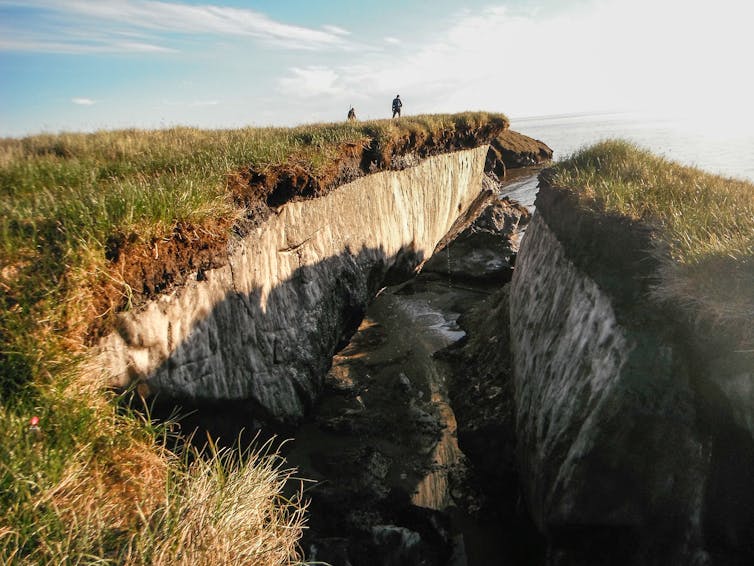
Erosion reveals ice-rich permafrost near Teshekpuk Lake, Alaska.
Historically, most water going into Arctic rivers flows atop frozen permafrost soils in spring. Scientists call this “overland runoff.”
However, our results suggest that as warming continues, an increasing fraction of annual river flow will come from under the surface, through thawed soils in the degrading permafrost. As the overall flow increases with more precipitation, as much as 30% more of it could be moving underground by the end of this century as subsurface pathways expand.
When water flows through soil, it picks up different chemicals and metals. As a result, water coming into rivers will likely have a different chemical character. For example, it may carry more nutrients and dissolved carbon that can affect coastal zones and the global climate. The fate of that mobilized carbon is an active area of study.
More carbon in river water could end up “outgassed” upon reaching placid coastal waters, increasing the amount of carbon dioxide released into the atmosphere, which further drives climate warming. The thaw is also revealing other nasty surprises, such as the emergence of long-frozen viruses.
More rain and snow, more runoff
The Arctic’s water cycle is also ramping up as temperatures rise, meaning more precipitation, evaporation, plant transpiration and river discharge. This is primarily due to a warmer atmosphere’s inherent ability to hold more moisture. It’s the same reason that bigger snowstorms are occurring as the climate warms.
Our study found that the bulk of the additional precipitation will occur across far northern parts of the Arctic basin. As sea ice disappears in a warming climate, computer models agree that a more open Arctic Ocean will feed more water to the atmosphere, where it will be transported to adjacent land areas to fall as precipitation.
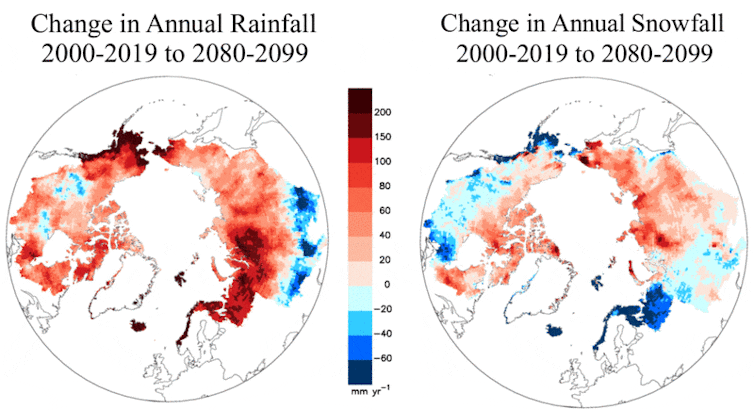
Changes projected this century in annual rainfall and snowfall simulated by the computer model used in the study. Red areas represent increases.
More snow in northern Alaska, Siberia and Canada will lead to more water flowing in rivers, potentially up to 25% more under a high-warming scenario based on our research. There is more carbon in the soil in northern parts of the Arctic compared with the south. With permafrost thaw, those regions will also see more water coming into rivers from below the surface, where additional soil carbon can leach into the water and become dissolved organic carbon.
More old carbon is already showing up in samples gathered from Arctic rivers, attributed to permafrost thaw. Carbon dating shows that some of this carbon has been frozen for thousands of years.
Impacts will cascade through Arctic ecosystems
So, what does the future hold?
One of the most notable changes expected involves the transport of fresh water and associated materials, such as dissolved organic carbon and heat energy, to Arctic coastal zones.
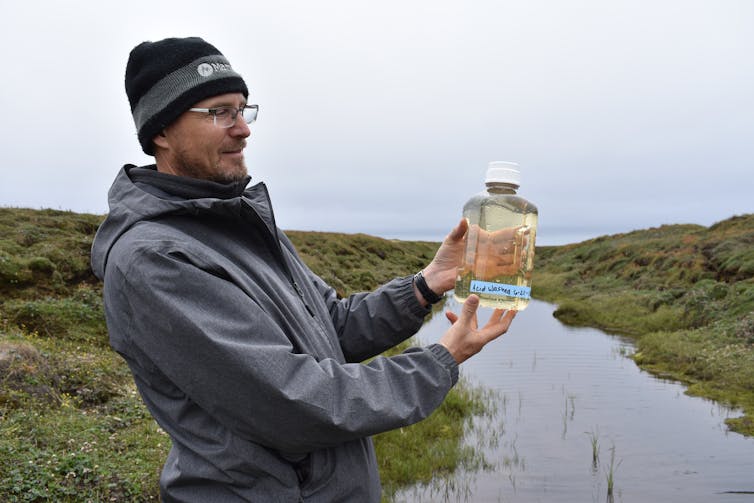
Coastal lagoons may become fresher. This change would affect organisms up and down the food chain, though our current understanding of the potential affects of changes in fresh water and dissolved organic carbon is still murky.
River water will also be warmer as the climate heats up and has the potential to melt coastal sea ice earlier in the season. Scientists observed this in spring 2023, when unusually warm water in Canada’s Mackenzie River carried heat to the Beaufort Sea, contributing to early coastal sea ice melting.

Finally, more river water reaching the coast has the potential to freshen the Arctic Ocean, particularly along northern Eurasia, where big Russian rivers export massive amounts of fresh water each year.
There are concerns that rising river flows in that region are influencing the Atlantic Meridional Overturning Circulation, the currents that circulate heat from the tropics, up along the U.S. East Coast and toward Europe. Evidence is mounting that these currents have been slowing in recent years as more fresh water enters the North Atlantic. If the circulation shuts down, it would significantly affect temperatures across North America and Europe.
At the coast, changing river flows will also affect the plants, animals and Indigenous populations that call the region home. For them and for the global climate, our study’s findings highlight the need to closely watch how the Arctic is being transformed and take steps to mitigate the effects.
Authors
Associate Director, Climate System Research Center and Associate Professor of Climatology, UMass Amherst
Assistant Professor of Geosciences, University of Rhode Island
Disclosure statement
Michael A. Rawlins receives funding from The Department of Energy, the National Aeronautics and Space Administration and the U.S. National Science Foundation.
Ambarish Karmalkar receives funding from the Department of Energy and the United States Geological Survey.
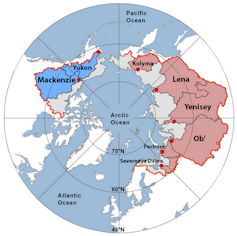
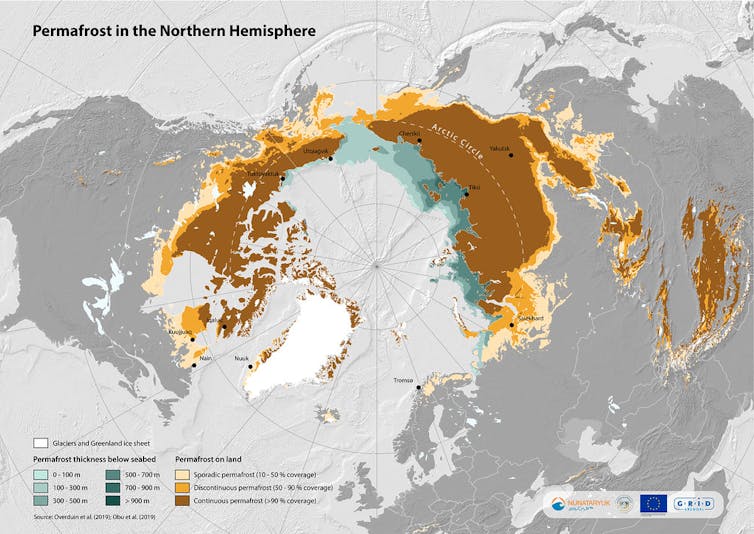
No comments:
Post a Comment